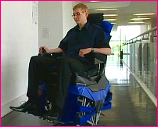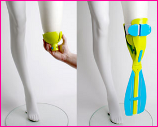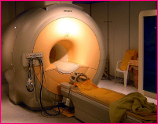Posted on June 19th, 2011 by Mary Lord
 A British product-design student has invented a wheel-chair alternative whose legs can lift up and step over obstacles. Martin Harris, 21, hopes his invention will give people with mobility issues more freedom. He also believes his design, which was inspired by the kinetic sculpture of Dutch engineer-artist Theo Jansen, has potential uses in agricultural machinery or military vehicles.
A British product-design student has invented a wheel-chair alternative whose legs can lift up and step over obstacles. Martin Harris, 21, hopes his invention will give people with mobility issues more freedom. He also believes his design, which was inspired by the kinetic sculpture of Dutch engineer-artist Theo Jansen, has potential uses in agricultural machinery or military vehicles.
Read More
Filed under: K-12 Education News, Special Features | Comments Off on Student Invents ‘Walking Chair’
Tags: adaptive technologies, Biomedical, Biomedical Engineering, Design, Mechanical engineering, student invention
Posted on January 31st, 2011 by Jaimie Schock
 In this video, Sport Science takes a deeper look into concussions caused from helmet to helmet collisions. It exams the different factors involved and offers statistics on concussions and collisions in the NFL.
In this video, Sport Science takes a deeper look into concussions caused from helmet to helmet collisions. It exams the different factors involved and offers statistics on concussions and collisions in the NFL.
Read More
Filed under: Web Resources | 2 Comments »
Tags: Biomedical, Biomedical Engineering, Sports, Sports Engineering, Videos
Posted on January 2nd, 2011 by ASEE
 Even unsuccessful contestants in the FIRST Lego League competition come up with imaginative ideas. A case in point is the team from Urbandale, Iowa. Challenged to build robots to tackle a biomedical engineering problem, they decided on cataracts.
Even unsuccessful contestants in the FIRST Lego League competition come up with imaginative ideas. A case in point is the team from Urbandale, Iowa. Challenged to build robots to tackle a biomedical engineering problem, they decided on cataracts.
Read More
Filed under: K-12 Education News | Comments Off on Students Pick Cataracts as their FIRST Challenge
Tags: Biomedical, Biomedical Engineering, Competitions for Students, LEGOS, Robotics
Posted on December 12th, 2010 by ASEE
 Student in grades 4 – 8 are introduced to biomedical engineering and the technology of prosthetics. As they create a model prosthetic lower leg, testing its strength and considering pros and cons, they learn about issues and materials that biomedical engineers consider in designing artificial limbs.
Student in grades 4 – 8 are introduced to biomedical engineering and the technology of prosthetics. As they create a model prosthetic lower leg, testing its strength and considering pros and cons, they learn about issues and materials that biomedical engineers consider in designing artificial limbs.
Read More
Filed under: Grades 6-8, Lesson Plans | Comments Off on Lesson: Build a Prosthetic Device
Tags: Biomedical Engineering, Grades 4-9, Prosthetics
Posted on December 12th, 2010 by Jaimie Schock
 For people with damaged or painful joints, something like a knee or hip replacement can be the key to a better life. It can also weaken, wear out, or break. That’s where mechanical and bioengineering Prof. Lisa Pruitt comes in.
For people with damaged or painful joints, something like a knee or hip replacement can be the key to a better life. It can also weaken, wear out, or break. That’s where mechanical and bioengineering Prof. Lisa Pruitt comes in.
Read More
Filed under: Special Features | Comments Off on Feature: A Joint Effort
Tags: Biomedical Engineering, Biotechnology, Higher Education, Research
Posted on December 12th, 2010 by Jaimie Schock
 A team of research engineers at golf equipment company PING has created a set of custom-fitted golf clubs for a man who has been a quadruple amputee since 2005. The researchers developed “a workable prototype” for Mesa, Arizona’s Jeff Lewis and worked with a prosthetist to develop a set of unique clubs.
A team of research engineers at golf equipment company PING has created a set of custom-fitted golf clubs for a man who has been a quadruple amputee since 2005. The researchers developed “a workable prototype” for Mesa, Arizona’s Jeff Lewis and worked with a prosthetist to develop a set of unique clubs.
Read More
Filed under: Special Features | Comments Off on Custom Golf Clubs for Quadruple Amputee
Tags: Biomedical, Biomedical Engineering, Corporations, Prosthetics, Sports, Sports Engineering
Posted on December 12th, 2010 by ASEE
 Fit and athletic amputees – like sprinter/long-jumper Aimee Mullins – have proved over and over that the loss of a limb is no reason to give up sports. Amputee swimmers, however, have been held back — until now. Enter Neptune, a colorful but functional superflipper designed for competitive amputee swimmers.
Fit and athletic amputees – like sprinter/long-jumper Aimee Mullins – have proved over and over that the loss of a limb is no reason to give up sports. Amputee swimmers, however, have been held back — until now. Enter Neptune, a colorful but functional superflipper designed for competitive amputee swimmers.
Read More
Filed under: Special Features | Comments Off on Superflipper Puts Amputees in the Competitive Swim
Tags: Biomedical, Biomedical Engineering, Prosthetics
Posted on October 18th, 2010 by ASEE
 Thinking like safety engineers, students in grades 11 and 12 examine the potential risks associated with magnetic resonance imaging, or MRI. They gather information by brainstorming, writing in journals, and viewing a video, and then produce a final presentation that concisely summarizes MRI technology and safety precautions.
Thinking like safety engineers, students in grades 11 and 12 examine the potential risks associated with magnetic resonance imaging, or MRI. They gather information by brainstorming, writing in journals, and viewing a video, and then produce a final presentation that concisely summarizes MRI technology and safety precautions.
Read More
Filed under: Grades 9-12, Lesson Plans | Comments Off on Lesson: MRI Safety Challenge
Tags: Biomedical Engineering, Grades 11-12, Safety engineering
Posted on August 16th, 2010 by ASEE
 A Texas bioengineering professor believes that students will be more ready for college science and engineering if exposed to university-level research while still inhigh school. He’s testing that notion with the help of a $500,000 National Science Foundation grant that brings students into his neuro-tissue lab to help with engineering research and then studies their progress.
A Texas bioengineering professor believes that students will be more ready for college science and engineering if exposed to university-level research while still inhigh school. He’s testing that notion with the help of a $500,000 National Science Foundation grant that brings students into his neuro-tissue lab to help with engineering research and then studies their progress.
Read More
Filed under: K-12 Education News | Comments Off on High-End Science for High School Students
Tags: Biomedical Engineering, Chemistry, Programs for Students, Research on Learning
 A British product-design student has invented a wheel-chair alternative whose legs can lift up and step over obstacles. Martin Harris, 21, hopes his invention will give people with mobility issues more freedom. He also believes his design, which was inspired by the kinetic sculpture of Dutch engineer-artist Theo Jansen, has potential uses in agricultural machinery or military vehicles.
A British product-design student has invented a wheel-chair alternative whose legs can lift up and step over obstacles. Martin Harris, 21, hopes his invention will give people with mobility issues more freedom. He also believes his design, which was inspired by the kinetic sculpture of Dutch engineer-artist Theo Jansen, has potential uses in agricultural machinery or military vehicles. 








 In this video, Sport Science takes a deeper look into concussions caused from helmet to helmet collisions. It exams the different factors involved and offers statistics on concussions and collisions in the NFL.
In this video, Sport Science takes a deeper look into concussions caused from helmet to helmet collisions. It exams the different factors involved and offers statistics on concussions and collisions in the NFL. Even unsuccessful contestants in the FIRST Lego League competition come up with imaginative ideas. A case in point is the team from Urbandale, Iowa. Challenged to build robots to tackle a biomedical engineering problem, they decided on cataracts.
Even unsuccessful contestants in the FIRST Lego League competition come up with imaginative ideas. A case in point is the team from Urbandale, Iowa. Challenged to build robots to tackle a biomedical engineering problem, they decided on cataracts. Student in grades 4 – 8 are introduced to biomedical engineering and the technology of prosthetics. As they create a model prosthetic lower leg, testing its strength and considering pros and cons, they learn about issues and materials that biomedical engineers consider in designing artificial limbs.
Student in grades 4 – 8 are introduced to biomedical engineering and the technology of prosthetics. As they create a model prosthetic lower leg, testing its strength and considering pros and cons, they learn about issues and materials that biomedical engineers consider in designing artificial limbs. For people with damaged or painful joints, something like a knee or hip replacement can be the key to a better life. It can also weaken, wear out, or break. That’s where mechanical and bioengineering Prof. Lisa Pruitt comes in.
For people with damaged or painful joints, something like a knee or hip replacement can be the key to a better life. It can also weaken, wear out, or break. That’s where mechanical and bioengineering Prof. Lisa Pruitt comes in. A team of research engineers at golf equipment company PING has created a set of custom-fitted golf clubs for a man who has been a quadruple amputee since 2005. The researchers developed “a workable prototype” for Mesa, Arizona’s Jeff Lewis and worked with a prosthetist to develop a set of unique clubs.
A team of research engineers at golf equipment company PING has created a set of custom-fitted golf clubs for a man who has been a quadruple amputee since 2005. The researchers developed “a workable prototype” for Mesa, Arizona’s Jeff Lewis and worked with a prosthetist to develop a set of unique clubs.  Fit and athletic amputees – like sprinter/long-jumper Aimee Mullins – have proved over and over that the loss of a limb is no reason to give up sports. Amputee swimmers, however, have been held back — until now. Enter Neptune, a colorful but functional superflipper designed for competitive amputee swimmers.
Fit and athletic amputees – like sprinter/long-jumper Aimee Mullins – have proved over and over that the loss of a limb is no reason to give up sports. Amputee swimmers, however, have been held back — until now. Enter Neptune, a colorful but functional superflipper designed for competitive amputee swimmers. Thinking like safety engineers, students in grades 11 and 12 examine the potential risks associated with magnetic resonance imaging, or MRI. They gather information by brainstorming, writing in journals, and viewing a video, and then produce a final presentation that concisely summarizes MRI technology and safety precautions.
Thinking like safety engineers, students in grades 11 and 12 examine the potential risks associated with magnetic resonance imaging, or MRI. They gather information by brainstorming, writing in journals, and viewing a video, and then produce a final presentation that concisely summarizes MRI technology and safety precautions. A Texas bioengineering professor believes that students will be more ready for college science and engineering if exposed to university-level research while still inhigh school. He’s testing that notion with the help of a $500,000 National Science Foundation grant that brings students into his neuro-tissue lab to help with engineering research and then studies their progress.
A Texas bioengineering professor believes that students will be more ready for college science and engineering if exposed to university-level research while still inhigh school. He’s testing that notion with the help of a $500,000 National Science Foundation grant that brings students into his neuro-tissue lab to help with engineering research and then studies their progress.